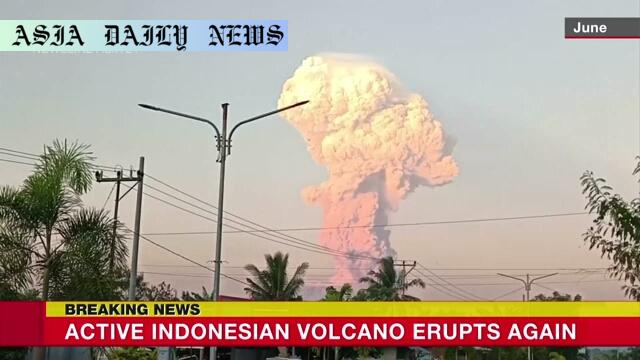Volcanic Eruption: Indonesia’s Mount Lewotobi Laki Laki erupted, ash cloud reached 18 km, potential tsunami threat to Japan.
Volcanic Eruption: Mount Lewotobi Laki Laki erupted at 11 a.m. causing an ash cloud 18KM high.
Japan’s Meteorological Agency monitors for potential tsunami hitting Okinawa at 3:30PM.
The volcano has erupted frequently with prior incidents in November, March, and June.

Overview of Mount Lewotobi’s Latest Eruption
The active volcano Mount Lewotobi Laki Laki in Indonesia erupted on Monday at approximately 11 a.m. local time. The eruption expelled a massive ash plume reaching an astounding height of 18 kilometers into the atmosphere. This significant natural phenomenon raises substantial concerns for regions within its potential impact range.
Indonesia, part of the Ring of Fire and one of the most volcanically active regions on Earth, has been witness to the destructive capabilities of Mount Lewotobi before. The volcano is notorious for repeated eruptions, with prior activities recorded in November, March, and June, each incident causing its own range of impacts.These volcanic episodes underscore the precarious nature of living near some of the Earth’s most active volcanoes.
Concerns over Tsunami Risks
Aside from the ash cloud, perhaps the most pressing concern brought about by this eruption is the potential for a tsunami. According to Japan’s Meteorological Agency, atmospheric pressure caused by the eruption could lead to the formation of a tsunami, which might reach Japan’s Okinawa prefecture as early as 3:30 p.m. local time. It is important to note, however, that as of this reporting, the occurrence of a tsunami has not yet been confirmed. Countries across the Pacific are on high alert as data continues to be analyzed. This crucial waiting period highlights the unpredictable and potentially devastating nature of volcanic eruptions in seismically active zones.
Historical Eruptions and Impacts
Mount Lewotobi’s tumultuous history has caused widespread concern in the past. In November 2022, one of its eruptions claimed lives, disrupted livelihoods, and caused significant damage to surrounding ecosystems. In subsequent eruptions in March and June of this year, there were further disruptions with long-term consequences for the local population. With this latest eruption, emergency services and volcano monitoring agencies are likely to ramp up their preparedness in an attempt to mitigate the potential risks that come with such a dynamic and unstable geological feature.
Preparedness and Monitoring Efforts
Indonesian authorities are actively monitoring the situation and issuing advisories where needed. Unfortunately, despite advancements in technology, predicting the full extent of volcanic eruptions and related fallout, like tsunamis, remains a challenge. The Indonesian volcano monitoring agency continues to study the event to offer the most accurate updates. Communities within the vicinity of the volcano are urged to stay vigilant and heed any evacuation measures or safety instructions. This eruption serves as a reminder of the importance of preparedness and the need for investment in disaster management infrastructure in regions prone to seismic activities.
The interconnectedness of the Pacific nations in battling shared natural disasters highlights the necessity for global cooperation in disaster preparedness. Monitoring efforts and early warning systems across multiple agencies will significantly contribute to minimizing risks and preventing avoidable losses.
Commentary
An Unsettling Reminder of Nature’s Power
The eruption of Mount Lewotobi Laki Laki serves as yet another stark reminder of the volatile and unpredictable behavior of the Earth. Living within the Pacific Ring of Fire is both a blessing and a curse for nations like Indonesia. While the region benefits from fertile volcanic soil that supports agriculture, it also endures the relentless threat of eruptions, earthquakes, and tsunamis. This duality defines life in these vibrant yet inherently risky areas.
Potential Tsunami: A Broader Warning
The possible formation of a tsunami resulting from this eruption amplifies the gravity of the situation. Japan, despite its technological prowess and preparedness, remains as vulnerable as any coastal nation when faced with natural disasters. The mere possibility has sent ripples of anxiety across the region, illuminating the necessity for a swift and coordinated international response in mitigating the impacts of such events.
The Challenge of Predicting Impacts
What adds to the complexity of such events is the difficulty in predicting the full range of consequences. While monitoring systems have advanced, there remain many unknowns when it comes to understanding volcanic and seismic behavior fully. This eruption should prompt renewed investment in scientific research to develop more precise predictive methodologies and disaster management protocols.
In conclusion, Mount Lewotobi’s eruption serves as a call to action, urging us to take stock of the delicate relationship we share with nature and the ongoing need to prepare and adapt to its formidable power. As the situation evolves, resilience and vigilance will be of utmost importance.


